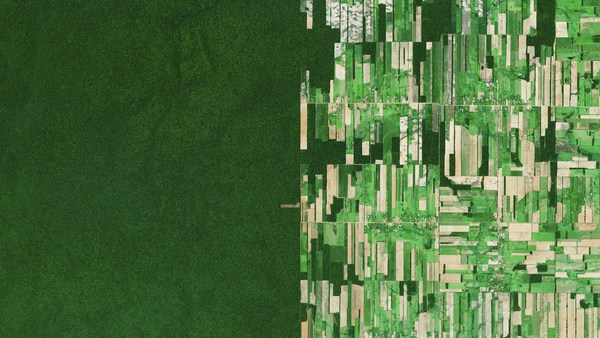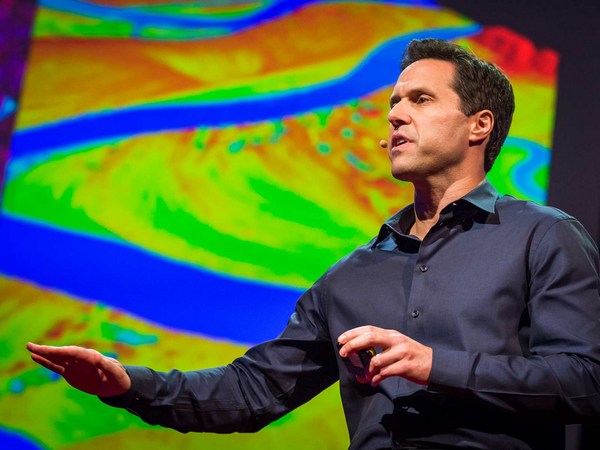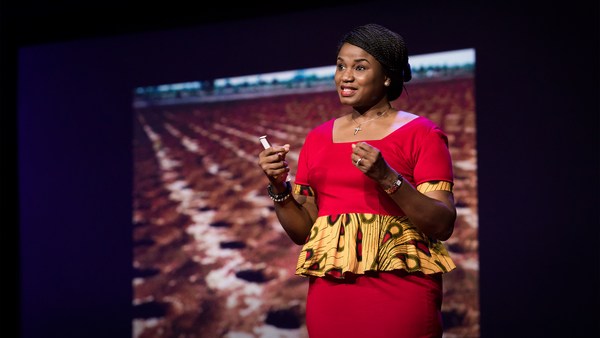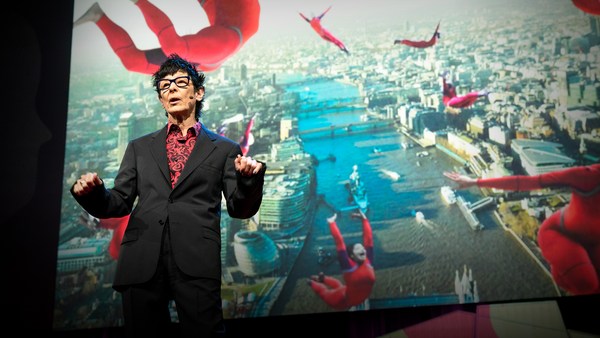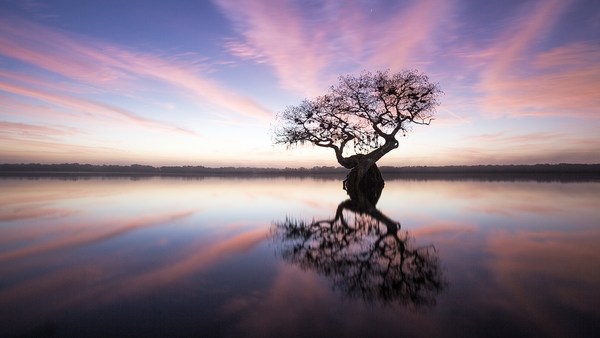I have to tell you, it's more than a little intimidating being up here, an old American guy trying to tell Africans something new about your own continent. But sometimes, an outsider can see things in a different way, like from the air. That's what I found by flying low and slow all over the African continent as I photographed the spectacle of its diversity. And I wasn't always an old guy.
(Laughter)
This is me in 1979, a kid from California backpacking his way through the Ituri Forest of Zaire. I was on a yearlong hitchhiking trip. I had just dropped out of Stanford University, and I went from Tunis to Kisangani to Cairo and learned how to live on 10 dollars a day. It was an amazing experience for me.
I spent about a week in this Dinka cattle camp on the banks of the Nile in South Sudan. The Dinka taught me how to tie papyrus into a shelter, and also I observed how they had adapted their way of life around the migratory needs of their beloved cattle. It was a like a graduate course in ecological ethnography, and I got busy taking notes with a camera.
With no money for rides, they often made the Mzungu ride on the roof of the trucks, or in this case, on the top of the train going across South Sudan. I felt like I was riding on the back of an insect going across the enormous tapestry of Africa. It was an incredible view from up there, but I couldn't help but think, wouldn't it be even more amazing if I could fly over that landscape like a bird?
Well, that notion stayed with me, and 20 years later, after becoming a professional photographer, I was able to talk National Geographic into doing a big story in the central Sahara, and I came back with a new kind of flying machine. This is me piloting the world's lightest and slowest aircraft.
(Laughter)
It's called a motorized paraglider. It consists of a backpack motor and a parachute-style wing, and it flies at about 30 miles an hour. With 10 liters of fuel, I can fly for about two hours, but what's really amazing about it is it gives me an unobstructed view, both horizontally and vertically, like a flying lawn chair.
My hitchhiker's dream of flying over Africa came true when I spotted these two camel caravans passing out in the middle of the Sahara. The one in the foreground is carrying salt out of the desert, while the one in the background is carrying fodder for the animals heading back in. I realized you couldn't take this kind of picture with a conventional aircraft. An airplane moves too fast, a helicopter would be too loud with too much downdraft, and it dawned on me that this crazy little aircraft I was flying would open up a new way of seeing remote parts of the African landscape in a way that had never really been possible before. Let me show you how it works.
(Applause)
Thanks.
(Applause)
This may seem a bit dangerous, but I am not some kind of adventure dude. I'm a photographer who flies, and I only fly to take pictures. My favorite altitude is between 200 and 500 feet, where I can see the world three-dimensionally, but also at a human scale. I find that a lot of what I'd done over the years in Africa, you could try to do with a drone, but drones aren't really made for exploration. They only fly for about 20 minutes of battery life and about three kilometers of range, and all you get to see is what's on a little screen.
But I like to explore. I want to go over the horizon and find new things, find weird stuff, like this volcanic caldera in Niger. If you look at the altimeter on my left leg, you'll see that I'm about a mile above takeoff. Flying that high really freaked me out, but if you talk to a pro pilot, they'll tell you that altitude is actually your friend, because the higher you are, the more time you have to figure out your problems.
(Laughter) As a rank amateur, I figured this gave me more time to scream on the way back down.
(Laughter) To calm myself down, I started taking pictures, and as I did, I became rational again, and I was getting buffeted by a Harmattan wind which was coming out of the upper right hand corner of this picture, and I started to notice how it had filled the entire crater with sand.
When I got to the north of Chad, I found a different kind of volcano. These had had their entire exteriors stripped away, and all that was left was the old core, and in the middle of the Sahara, I felt like I was seeing the earth with its living skin stripped away.
Much of the Sahara is underlain by an enormous freshwater aquifer. When you go to the basin, sometimes you can see it leaking out. If you were to walk through those palm groves, you could drink fresh water out of your footsteps. But that green lake water? Due to extreme evaporation, it's saltier than seawater and virtually lifeless.
In Niger, I was amazed to see how the locals learned how to exploit a different kind of desert spring. Here, they mix the salty mud with spring water and spread it out in shallow ponds, and as it evaporated, it turned into a spectacle of color. My rig is also amazing for looking at agriculture. This picture was taken in southern Algeria, where the locals have learned how to garden in a mobile dune field by tapping into shallow groundwater.
I also loved looking at how animals have adapted to the African landscape. This picture was taken in Lake Amboseli, just across the border from here in Kenya. The elephants have carved the shallow lake water up into a network of little pathways, and they're spaced just enough apart that only elephants, with their long trunks, can tap into the most succulent grasses.
In Namibia, the zebra have learned how to thrive in an environment that gets no rainfall at all. These grasses are irrigated by the dense coastal fog that blankets the area every morning. And those bald patches out there? They call them fairy circles, and scientists still struggle to understand what causes them.
This is Mount Visoke, with a small crater lake in its summit at 3,700 meters. It forms the roof of the Great Rift Valley and also the border between Rwanda and Congo. It's also the center of the reserve for the fabled mountain gorilla. They're actually the big money-maker in Rwanda, and on this side of the border, conservation has become a huge success.
Rwanda has the highest rural population density in Africa, and I saw it in almost every corner of the country I went to. I've heard it said that competition for land was one of the things that led to the tensions that caused the genocide of the 1990s.
I went back to South Sudan a few years ago, and it was amazing to see how much things had changed. The Dinka were still in love with their cattle, but they had turned in their spears for Kalashnikovs. The cattle camps from above were even more spectacular than I could have imagined, but things had changed there too. You see those little blue dots down there? The Dinka had adapted to the new reality, and now they covered their papyrus shelters with the tarps from UN food convoys.
In Mali, the Bozo people have learned how to thrive in the pulsating rhythms of the Niger River. As the rainy season ends and the water subsides, they plant their rice in the fertile bottoms. And that village in the lower right corner, that's Gao, one of the jumping off points for the major trade routes across the Sahara. At the end of the harvest, the Bozo take the leftover rice straw and they mix it with mud to reinforce their roofs and the village mosque. I must have flown over a dozen villages like this along the Niger River, and each one was unique, it had a different pattern. And each mosque was like a sculptural masterpiece, and no two were alike.
I've flown all over the world, and nothing can really compare to the cultural diversity of Africa. You see it in every country, from Morocco to Ethiopia, to South Africa, to Mozambique, to South Sudan, to Mali. The array of environments and cultural adaptations to them is really extraordinary, and the history is pretty cool too.
From the air, I have a unique window into the earliest waves of colonial history. This is Cyrene on the coastal mountains of Libya, that was founded by the Greeks, in 700 BC, as a learning center, and Timgad, which was founded in what's now Algeria by the Romans in 100 AD. This was built as a retirement community for old Roman soldiers, and it amazed me to think that North Africa was once the breadbasket for the Roman Empire. But 700 years after Timgad was built, it was buried in sand, and even then, the African climate was wetter than it is today.
The African climate continues to change, and you see it everywhere, like here in the Gorges de Ziz, where a freak rainstorm came barreling out of the Sahara and blanketed the mountains in snow. I never thought I would see date palms in snow, but the kids that day had a great time throwing snowballs at each other. But it made me wonder, how are Africans going to adapt to this rapidly changing climate going forward?
In a continent as dynamic and diverse as Africa, sometimes it seems that the only constant is change. But one thing I've learned is that Africans are the ultimate improvisers, always adapting and finding a way forward.
Thank you.
(Applause)
